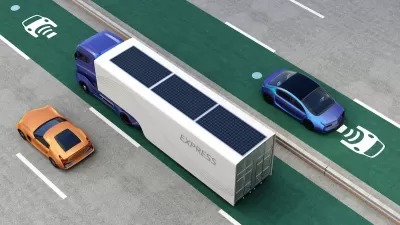The U.S. National Blueprint for Transportation Decarbonization is designed to guide federal investment and regulations, focusing on electrification with a nod to transit investment and walkability.

A ‘first of its kind’ federal plan sets out goals for cutting carbon emissions in the transportation sector, but postpones the biggest reductions to the 2030s and 2040s, according to an article by Ian Duncan in the Washington Post. “The blueprint doesn’t set out new, enforceable targets, but serves as a long-term guide for federal agencies tasked with writing climate rules and spending environmental funds,” Duncan explains.
The plan is based on three concepts: ‘convenient,’ which includes promoting more walkable communities; ‘efficient,’ including modes of transportation like buses and trains; and ‘clean,’ for fuels like batteries and hydrogen.
The plan relies on the adoption of electric vehicles for most of the reductions. As Duncan notes, “The infrastructure law included $7.5 billion for charging infrastructure, split between a network along highways that officials hope will give drivers confidence to take electric vehicles on long road trips, and a program designed to ensure that disadvantaged communities have access to chargers.” The law also includes a $7,500 electric vehicle tax credit (though it notably excludes credits for electric bikes). However, Duncan points out that “Electric vehicles accounted for less than 1 percent of miles driven in 2021 in the United States,” and the growing popularity of large trucks and SUVs is slowing any gains in emissions reduction.
Meanwhile, “many environmental advocates have urged state transportation agencies to limit the construction of new highways that tend to encourage driving, and instead invest money in alternative infrastructure, such as bus lanes and bike paths.” According to a Georgetown Climate Center study, “if money from the infrastructure law were invested in such green projects, it could contribute a further percentage point cut to emissions over the course of the decade.”
For more information, also see a U.S. Department of Transportation press release announcing the U.S. National Blueprint for Transportation Decarbonization. The blueprint is also available online at the U.S. Department of Energy website.
FULL STORY: Biden administration plan seeks elimination of transportation emissions

Study: Maui’s Plan to Convert Vacation Rentals to Long-Term Housing Could Cause Nearly $1 Billion Economic Loss
The plan would reduce visitor accommodation by 25,% resulting in 1,900 jobs lost.

North Texas Transit Leaders Tout Benefits of TOD for Growing Region
At a summit focused on transit-oriented development, policymakers discussed how North Texas’ expanded light rail system can serve as a tool for economic growth.

Why Should We Subsidize Public Transportation?
Many public transit agencies face financial stress due to rising costs, declining fare revenue, and declining subsidies. Transit advocates must provide a strong business case for increasing public transit funding.

How Community Science Connects People, Parks, and Biodiversity
Community science engages people of all backgrounds in documenting local biodiversity, strengthening connections to nature, and contributing to global efforts like the City Nature Challenge to build a more inclusive and resilient future.

Alabama: Trump Terminates Settlements for Black Communities Harmed By Raw Sewage
Trump deemed the landmark civil rights agreement “illegal DEI and environmental justice policy.”

Dear Tesla Driver: “It’s not You, It’s Him.”
Amidst a booming bumper sticker industry, one writer offers solace to those asking, “Does this car make me look fascist?”
Urban Design for Planners 1: Software Tools
This six-course series explores essential urban design concepts using open source software and equips planners with the tools they need to participate fully in the urban design process.
Planning for Universal Design
Learn the tools for implementing Universal Design in planning regulations.
City of Santa Clarita
Ascent Environmental
Institute for Housing and Urban Development Studies (IHS)
City of Grandview
Harvard GSD Executive Education
Toledo-Lucas County Plan Commissions
Salt Lake City
NYU Wagner Graduate School of Public Service





























